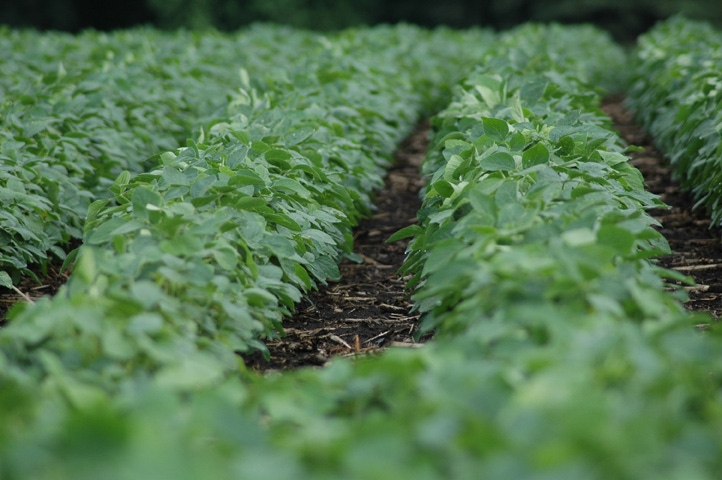January 10, 2011

Land rolling use has steadily increased, especially on soybean fields in the Upper Midwest during the past few years. The practice began in Canada several years ago, gained steam in North Dakota and Northwest Minnesota where it has become routine, and now has spread into Southern Minnesota and some areas in Iowa.
The essential concern or need to use a land roller is to push down rocks, breakdown residue and level the ground for harvest and subsequently reduce grain and yield losses. The idea is that rolling makes combining beans faster and easier, and there is less chance of picking up rocks or corn root clumps which can damage guards, sickle sections or expensive internal combine parts.
Some of these problems or challenges are legitimate, but they are not dominant in every field or landscape, given other economic and environmental risks involved with using a land roller. The economic benefits of such practice have been difficult to document, especially in yield advantage, seed quality or seed loss. The cost of purchasing a land roller depends on its size. The approximate costs, as provided by some equipment dealers, can range in price from $17,000 for a 20-ft., $32,000 for a 45-ft. and $65,000 for the 85-ft. model. Custom land rolling rates can range from $3/acre to $10/acre, averaging $6.55/acre, according to Iowa State’s 2010 Iowa Farm Custom Rate Survey.
Research on using a land roller in Iowa and Minnesota showed no yield advantage in soybeans with rolling at different times and growth stages (see related gallery for table). Such data suggests costs are not covered by additional yield.
Impact on soil and water quality is a potential concern. Using a land roller during early spring and for multiple times (i.e., before and after planting) can create significant soil surface compaction, destroy soil surface aggregates and detach residue leading to a potential increase in soil erosion. Preliminary research from Iowa State University documents that land rolling a field reduced water infiltration. Reduced infiltration leads to increased surface runoff after rain events. The findings show a significant decrease in water infiltration by over three times the rate of control (non-rolled plots). This is a one-year evaluation and research will continue in 2011.
Degradation of soil and water quality
Degradation of soil and water quality is not only a problem in the short term, but also has a long-term impact. Potential nutrient loss of phosphorous and nitrogen is also a concern, especially in the spring where a significant number of rain events and amounts are received in the Midwest region. In order to reduce surface runoff, conservation practices that reduce soil compaction (i.e., maintaining an intact residue cover) are essential to protect our soil and sustain our water and environment quality. Regardless of the tillage system that the land roller will be used on, land rolling can destroy soil benefits associated with no-till or add additional damage if used on conventionally tilled ground, where intensive tillage has already destroyed soil structure.
The University of Minnesota researchers observed that land rolling may raise the risk of sealing the soil surface during rain events, which can lead to ponding, as was also found in Iowa. The consequences of reducing water infiltration into the soil profile increases the potential for surface runoff and loss of top soil and nutrients by erosion, thereby reducing crop productivity and yield. Also, compacted soil surface may lead to wet soil surface conditions that can have other effects, such as an increase in soil-born disease, especially in poorly drained soils, as found in a majority of Minnesota and northern Iowa fields. The Minnesota and Iowa findings confirmed earlier research by North Dakota State University (NDSU). Research in 2003 and 2004 from NDSU concluded that no yield loss from land rolling is observed, but injury levels go up if rolling was delayed until the first trifoliate stage, when plants are 3-4 in. tall.
Farmers’ desire to increase harvestability by pushing down rocks and corn root balls should be carefully balanced with the long-term effects of rolling on soil quality and water resources. Potential effects on surface soil compaction as well as additional time, fuel and machinery cost of land rolling need to be considered since yield advantage or harvest loss from using this practice seems inconsistent at best. Earlier research shows that if the beans are standing well and the combine is properly adjusted, stubble cut loss is less than 1 bu./acre, and should be closer to ½ bu.
There are a lot of good alternative technologies to adjust and calibrate the combine correctly and manage residue and other farming challenges. If the issue is to remove rocks from the field, then this may not be the most efficient solution. Pushing rocks into the soil is a short-term solution, especially when fields will be tilled again the following season and the rocks brought back to the soil surface.
The bottom line is that while the use of a land roller may provide some comfort and “peace of mind,” and may reduce combine breakdown in some fields, it also carries risks and potential impacts to soil and water quality in the short as well as in the long-term.
You May Also Like




